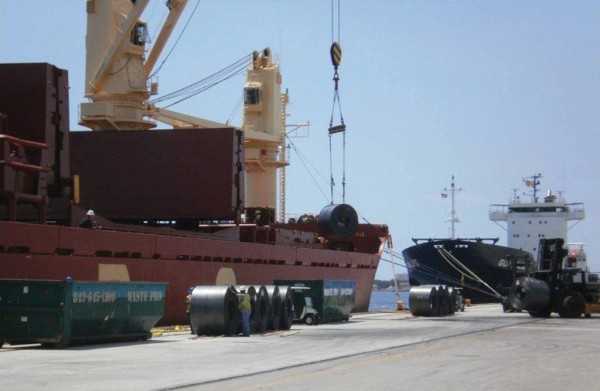The South Jersey Port Corporation anticipates steel volumes, savaged by the COVID-19 global recession and punishing Trump tariffs, will increase significantly this winter as manufacturers replenish inventories to gear up production and as COVID-19 vaccines come online, signaling an anticipated control of the pandemic.
SJPC’s Camden terminal handled 461,000 tons of steel coil in 2020, down from 529,000 in 2019, a 13% decrease. Steel slabs handled at the Paulsboro Marine Terminal were down to 535,000 tons in 2020 from 1.2 million tons in 2019, a 55% drop.

Early indications of 2021’s volumes show a potential 50% increase in overall steel tonnage handled at South Jersey ports during the first quarter, according to Brendan Dugan, assistant executive director at the South Jersey Port Corporation. If that pace is sustained, 2021’s volume would still put the port around 20% below 2018 steel levels.
Steel volumes in Camden and Paulsboro normally increase between January and March, noted Dugan, because the Saint Lawrence Seaway is not available for shipments to the industrial Midwest. SJPC ports are within a day’s truck haul of industrial facilities in the Northeast, the Midwest, and eastern Canada, he added.
Around 40% of the winter steel moving through SJPC’s Balzano Marine Terminal in Camden is transported by rail in box cars and covered coil cars to manufacturing locations in Illinois, Michigan, Ohio, Wisconsin, Tennessee, North Carolina, and South Carolina. Conrail provides the switching service at the port, while Norfolk Southern and CSX provide the Class I rail service to points west and south.
The SJPC recently completed the rebuilding of its rail loading dock and rail siding and is investing $7 million for further upgrades. The New Jersey Department of Transportation (NJDOT) NJDOT has provided SJPC with over $10 million in the last five years for rail improvement projects through the state’s Rail Freight Assistance Program (RFAP), which grants funding of between 70% and 90% of approved rail project costs.
Tata Steel Europe and Thyssen Krupp Steel North America use the Balzano Marine Terminal throughout the year but particularly during the winter to bring steel coils from the Netherlands and Germany to their manufacturing plants in Pennsylvania and Ohio and to other buyers, including automobile manufacturing plants, throughout the Midwest. In 2019, Tata Steel International and Thyssen Krupp Steel accounted for 16% of the SJPC steel imports.
NLMK, the Russian steel company, accounts for over 60% of SJPC’s total ferrous product imports, operating year-round at the Paulsboro Marine Terminal to supply three U.S. finishing plants. “Tariffs on steel imports combined with the COVID pandemic depressed our steel import business in 2020, particularly NLMK’s imports from Russia,” said Dugan.
Imports of Brazilian steel have increased recently, mitigating some of the decline in Russian imports, but are constrained by quotas, Dugan noted. “The SJPC expects that trend to reverse this season,” he added, “as vaccines to neutralize the virus come online and the new administration in Washington helps to reinvigorate the global economy and consumer demand.”

Follow us on social media: